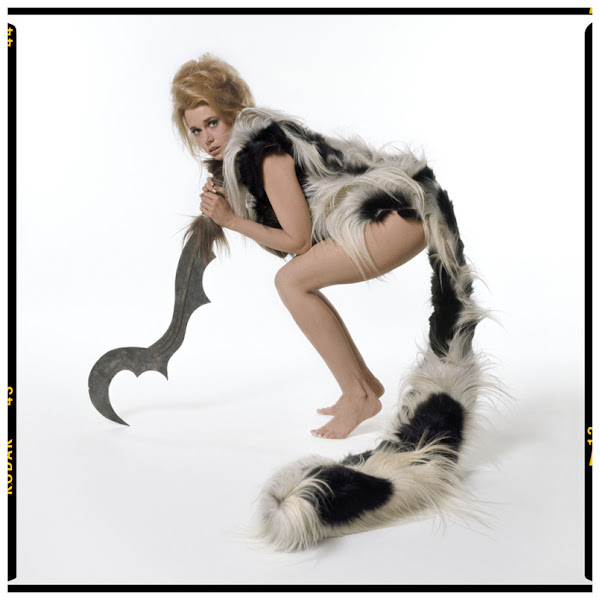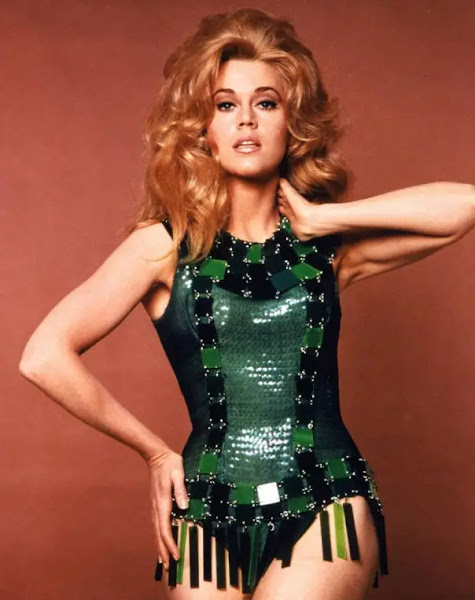A classic of science-fiction camp and perhaps the film responsible for propagating the image of the 'space babe' in the popular consciousness, Roger Vadim's adaptation of Jean-Claude Forest's sexually charged comic strip
Barbarella was as vibrant and tongue-in-cheek as a comic book adaptation should be.
Many articles erroneously credit the film's costume designs to fashion designer Paco Rabanne, but he did not have any real input in it other than that Jane Fonda's green costume was inspired by his dress designs. The costumes were entirely designed by Fonteray, and were constructed in Italy's Sartoria Farani costume house.
The titular Barbarella (Jane Fonda) is first seen in a spacesuit made entirely out of silvery material with green fabric at the joints, worn with a bulbous helmet, each part of the spacesuit being taken off one by one in the film's opening undressing sequence - of course publicity photos show Fonda in the suit with no leggings.
Barbarella's first 'space babe' outfit, as it may as well be called, sets the mold for most of the costumes in film - a tight black suit with tights, lined boots and the top worn with a ridged plastic chest plate, with see through plastic over a hole in the midriff, showcasing the use of unconventional materials, especially plastic in the film's various sexually charged costume designs.
Barbarella's second outfit is a small silvery top and cape, worn over bodystockings with silver boots, again - this is the first of Barbarella's costumes that gets severely damaged (in an, uh, 'revealing' fashion) in the film, with the second costume to suffer this fate also having a similar design mostly of fabric - the more complex costumes are unscathed.
When rescued by the Catchman, Barbarella is given a set of white and black furs that forms a one piece dress still showing her legs and arms, the dress being fixed with a long 'tail' which is of course tripped over and stuck in doorways.
After this outfit is another spacey costume design, with this one being perhaps the most conventional design in comparison - a silver top with black straps, worn with thigh-high silver boots, stuck on with black suspenders going all the way down to the tip of the boots.
When journeying into the evil city of Sogo, Barbarella sports another mostly fabric outfit with a metal section over the chest, again with a short silvery cape, worn with some very snappy red boots - like the previous fabric and metallic silver outfit, this gets its fabric parts torn up to show some skin.
The most risque outfit worn by Fonda for the film has to be this one after being rescued by Sogo's rebel movement - a black top again with a plastic section showing the midriff, but also over one of her breasts showing the nipples, worn with brown tights, boots and a polka dot cape.
Barbarella's final outfit is a very tasteful shimmering green dress with green ceramic pieces around the collar, sides and waist, worn with green boots - this was the one costume in the film inspired by Paco Rabanne's designs (to the point it is included in the end credits) and is the source of the erroneous crediting of Rabanne as costume designer - while inspired by Rabanne's work, this is still a design by Fonteray!
Barbarella is assigned the mission by the President of Earth, who is barely seen in the film, but is wearing a heavy fur-lined cape.
When Barbarella lands on the planet where the mission is lost, she is accosted by a bunch of savage little children, wearing shiny unitards of green, red and yellow; the girls wear striped dresses of white and red, with some in the background having white and yellow versions.
She is rescued from the murderous tykes by Mark Hand (Ugo Tognazzi), the 'Catchman' who is assigned to capture the feral children and bring them back to Sogo, and he is clad in a one-piece brown furred garment, with plumes of fur strands especially around the collar.
The residents of Sogo are all clad in a variety of ornate outfits, most of which consist of leather, vinyl, clear plastic or furs, usually in browns and blacks for the men, but other colours for the women.
Not all of Sogo's residents are dressed kinky; two girls wear deep pink dresses, and several others wear large headwear with gowns.
Sogo's guards are in brown or black leather armor with spikes coming out the shoulders and worn with coloured boots, with one woman guard having a striped beige and black top with pink leggings.
Barbarella is put to death, and is rescued at the last second by the rebel leader Dildano (David Hemmings), who sports a brown leather outfit which is adorned with chains as well as a cape fixed on with straps.
Barbarella eventually finds the missing Durand Durand (Milo O'Shea), who sports one of the film's most outlandish outfits, a white and black robe fixed with large piped shoulder pads, with the collar piece being made of brown blotched vinyl and a large black piece sticking from the front. The skirt of the robe is adorned with metallic pieces, with a green square on the back.
Durand Durand's second outfit worn for his 'coronation is just as elaborate but sadly doesn't get as many full shots, and is a ridged shiny purple tunic with a massive ruffed collar, with black fur around the edges and cuffs, worn with a brown cloak.
Durand Durand is supposedly serving the Black Queen of Sogo (Anita Pallenberg, who wears some more of the film's more outlandish and sexual outfits, her first one being a very obvious riff on classic dominatrix gear, with leather gloves, leggings and a burgundy top, with a plastic piece baring the midriff and chains on the side.
On her throne, the Black Queen sports an even more ornate outfit of a fur and stone dress with glittery pieces over the thin revealing fabric parts, worn with a plastic horn 'crown' and high-heels - perhaps one of the film's most remembered outfits past Barbarella's various costumes.
The Queen's last outfit is much more simple, being a furred nightdress, but is fixed with clear plastic (or glass?) hands around the neck, and worn with long black gloves.
Lastly, are the Queen's 'Black Guards', also known in the film as 'leathermen' - walking suits of brown leather armor, with faceless pointed helmets and a general design clearly inspired by the armor of medieval knights and samurai. These were realized on the screen by Italian special effects designer Carlo Rambaldi, I don't know as to if they were entirely his design, or translations of Fonteray's designs.
Costume Reuse Notes: The spacesuits seen briefly on the screen during the President of Earth's message to Barbarella had originally first appeared in Tinto Brass'
Il Disco Volante (1964).
David Hemmings' costume as Dildano was later reused in the atrociously dull Escape from Galaxy 3, which was also billed as a fake sequel to Starcrash no less!







































































